Polymorphism is the phenomenon of occurrence of the same species of the organism in more than one form with different functions. Polymorphism is a Greek word, polys meaning many and morphe meaning form.
This occurrence of polymorphism guarantees well-organized division of labor between several individuals. In coelenterates different individuals get united in the form of a colony and hence polymorphism is a very important feature of this phylum. Class hydrozoa is the best example of polymorphism.
There are two main forms included in the polymorphism of the coelenterates namely Polyps and meduase
Polyps: This form is tubular and the mouth is surrounded by tentacles only at one end while the other end is usually attached by a pedal disc to the substratum.
Meduase: This form is umbrella or bowl shaped with marginal tentacles and mouth centrally located on the projection of the lower concave surface.
Generally polyps are sessile and meduase forms are motile. But a homology exists between the two in their basic features.
Colonies of the order Siphonophora shows the highest degree of polymorphism showing greatest number of polyp and medusa forms. These are different schools of thought as to which of the two forms of polyp and medusa originated first during the evolution of Coelenterata.
According to one school of thought, the ancestral coelenterate was hydra-like polyp which arose from gastrea. This hydra like polyp gave rise to hydroid colony through asexual budding. In this sessile colony some polyp forms were modified into medusa forms for sexual reproduction and pelagic mode of life. And thus hydroid colony became polymorphic.
According to another school of thought given our by Brooks, the ancestral coelenterate was a primitive medusa which arose from metagastrea by developing tentacles and free swimming habit. The tentacles and the umbrella of this medusoid form were multiplied and shifted from their original positions to become zooids of the polymorphic colony. As per this thought polyp is considered to be persistent larval stage and medusa is the completely evolved coelenterate. This thought is most acceptable.
According to another view of Moser, various zooids of the siphonophorans are merely organs that have bot attained the grade of polymorphic individuals. Siphonophora is regarded ancestral to hydrozoa which has fully differentiated zooids. As per this thought poly-organs of Siphonophora differentiate and become poly persons of hydrozoa. This is the most disputable thought about the origin of polymorphism.
Different groups of hydrozoa show varying degree of polymorphisms. The following are various patters of polymorphism found in hydrozoa.
Dimorphic: This is the most simplest and the common pattern of polymorphism exhibited by most of the hydrozoan colonies. They have only two types of zooids and hence the name dimorphic. Dimorphic polymorphism is exhibited by many hydrozoan colonies like Obelia, Tubularia. The two types of zooids are,
Trimorphic: This polymorphic pattern bears an additional zooid called as dactylozooids along with gastrozooids and gonozooids.Dactylozooids are non-feeding, defensive structures consisting of batteries of nematocycts.
Polymorphic: Having more than three types of zooid individuals is termed as polymorphism. For example a colony of Hydractinia consists of five types of polyps each assigned with a special function,
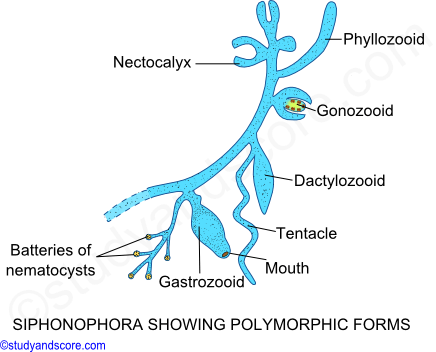
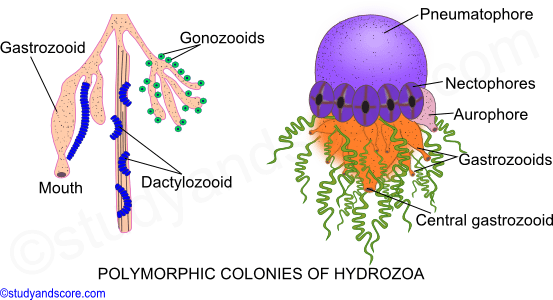
Polymorphism is the phenomenon mainly associated with the division of labor. Different functions are assigned to different individuals rather than different parts or organs of the body of the same individual. Polyp forms are associated with the feeding, protection and asexual reproduction while medusa forms are concerned mainly with sexual reproduction.
The body wall of all the coelenterates contains special defensive structures called as stinging cells or nematocysts. Because of the presence of these cnidocytes the phylum Coelenterata is also known as Cnidaria. Each cnidocyte contains a fluid filled membranous capsule called cnida. Cnidocytes help not only in defense but also in locomotion, adhesion and capture of prey.
The presence of these defensive structures is one of the most important characteristic features of coelenterates. These are not actually cells by are cell organelles found in the specialized cells called as cnidocytes or cnidoblasts. Cnidoblast is a Greek term “knide” meaning nettle and “blast” meaning germ.
Cnidoblasts develop only from modified interstitial cells of epidermis and are not found in the gastrodermis. When fully developed, cnidoblasts migrate to the tentacles through mesoglea by means of amoeboid movement.
Cnidoblast is an oval or rounded cell with a basal nucleus on one side. Inside the cnidoblast an oval or pyriform bladder called as stinging capsule is present. This stinging capsule is also called as nematocyst. The nematocyst consists of a tiny bulb made of chitin. This bulb is filled with poisonous fluid or hypnotoxin, which is chemically a mixture of proteins and phenols. On end of this bulb is extended as a narrow, long, hollow tube like filament which is coiled round the poisonous sac. This filament is called as thread tube. The base of the thread tube is swollen to form a shaft. Inside the shaft there are three large spines called as barbs and three spiral rows of minute spines called as barbules. The shaft is externally covered by a lid-like structure called as operculum.
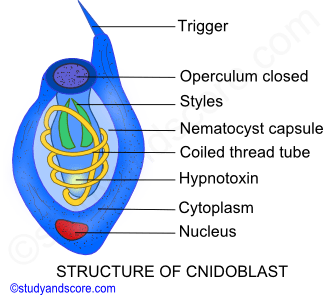
The outer end of the cnidoblast projects freely beyond the epidermal surface as a tiny, pointed hair-like process called cnidocil or trigger. Groups of supporting rods surround the central core of cnidocil. The central core is structurally similar to the cilium with fibers in 9+2 pattern. The cytoplasm of the cnidoblast contains contractile muscle fibrils.
The cell organelles present in the cytoplasm of the cnidoblast include endoplasmic reticulum, free ribosomes, Golgi bodies, mitochondria and multi-vesicular bodies as revealed by electron microscopic studies.
Nematocysts are found scattered single or in groups (very rare) throughout the epidermal region of the cnidarian body. These special defensive structures are absent on the basal disc. They are abundant at the oral region and on the tentacles where they form batteries of nematocysts.
A battery of nematocyst is the structure comprising of two large central nematocysts surrounded by 10-12 small nematocysts. All these large and small nematocysts are enclosed within a single large epithelio-muscle cell. Cnidoblasts are not formed in the tentacles rather they are formed in the epidermal region and then they migrate to the tentacles. During this migration of large number of cnidoblasts some of them encyst in clusters in gastro vascular cavity to form battery of nematocyst.
The discharge or explosion of nematocysts takes place when cnidocil is stimulated by food, prey or enemy. Both the presence of food and touch together initiates the process of explosion and not any one alone. Hence both the mechanical stimulations like contact of food and chemical stimulations like approaching enemy are involved in the mechanism of action of nematocysts.
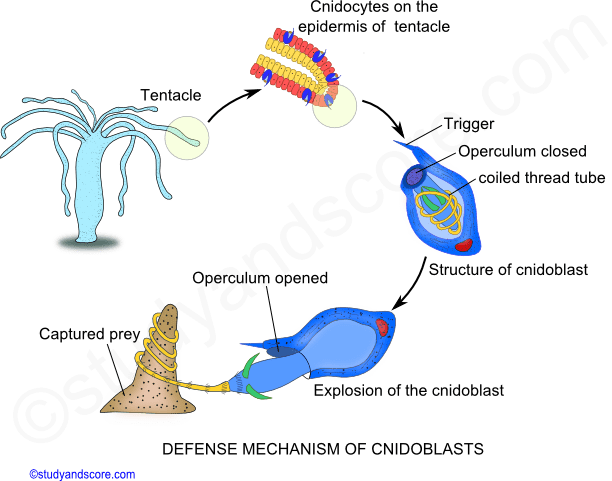
Though the exact mechanism of discharge and enzymes involved are not known, but is very much evident that the response is wholly local without the involvement of nervous system. The wall of nematocyst remains impermeable to water except during discharge. On stimulation, the wall of the capsule suddenly increases its permeability causing rapid intake of water and consequently the osmotic pressure inside the capsule increases. Now as a result the operculum is forced to open up, then the coiled thread tube turns inside out and finally the whole nematocyst explodes to the outside. As the thread tube everts, the barbs and barbules present inside the shaft unfold to the outside.
The thread tube once discharged cannot be withdrawn in other words; the nematocyst once exploded cannot be used again. After the explosion the cnidoblasts migrate to the gastro vascular cavity and are digested. The exploded nematocysts are replaced within 48 hours.
There are about 30 different types of nematocysts found in phylum Coelenterata. Their type is constant for particular species. As far as Hydra is concerned, there are four basic types of nematocysts which serve various functions. The following is the description of all of them.
Penetrant nematocyst: These are also known as stenotele. These kinds of nematocysts are very large and complex compared to other types. These nematocysts are pear-shaped almost occupying the entire space of cnidoblast in which it lies. Its thread is also long and hollow, coiled transversely and bearing three large barbs and three rows of small spines. When the thread tube is discharged, it shoots out with great explosive force to pierce the victim body and injects the poisonous fluid which paralyses or kills it outright. The hydra then seizes its prey with tentacles and draws it into its mouth.
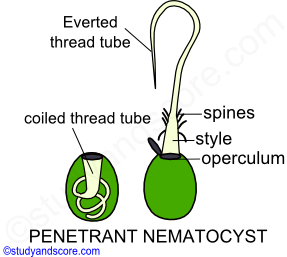
Volvent nematocyst: These are also known as desmoneme. These kinds of nematocysts are small and pear-shaped. They contain a short, thick, spineless Eleatic thread tube forming single loop. When discharged, it tightly coiled round the small projections like hair or bristles of the prey and thus stopping the movement of the prey.
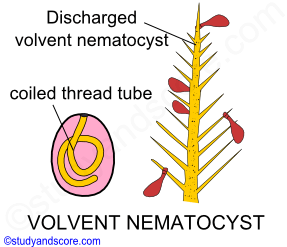
Stereoline glutinant nematocyst: These are also known as small glutinant atrichous isorhizas. These kinds of nematocysts are oval or elongated in shape. They do not have shaft. They discharge a straight unarmed thread tube open at the tip. This kind of nematocysts is useful in attachment and anchorage.
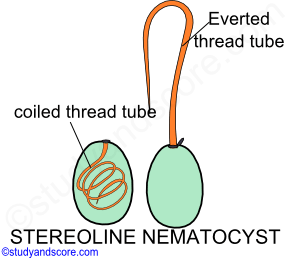
Streptoline glutinant nematocyst: These are also known as large glutinant or holotrichous isorhizas. These kinds of nematocysts are oval or cylindrical. Their thread tube is long with a narrow shaft which forms three or four coils. It bears a spiral row of small spines. These are mainly useful in attachment and to impede the movement of small animals.
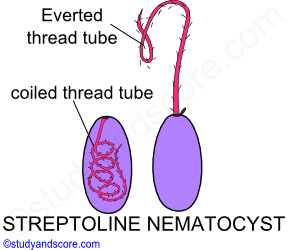

- Share with your friends! -
Login to post your comment here...
- or with social Account -